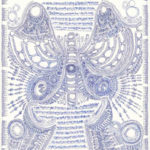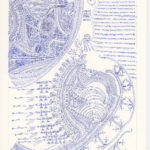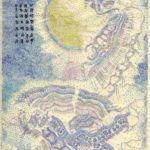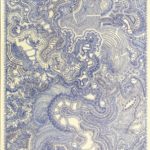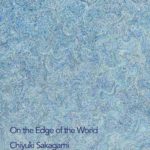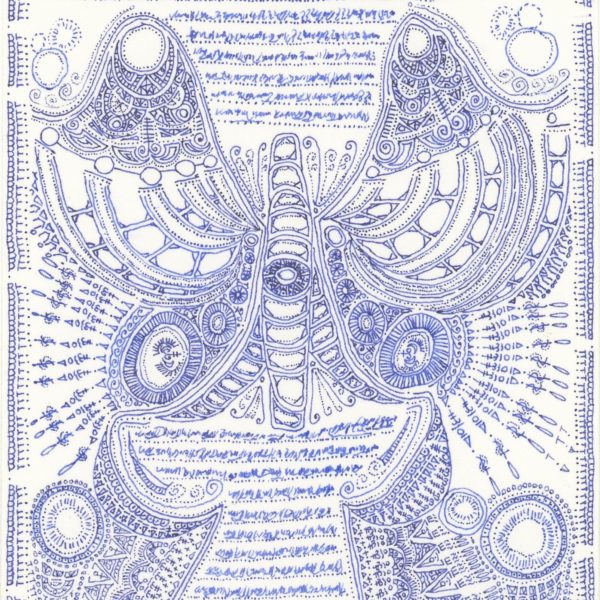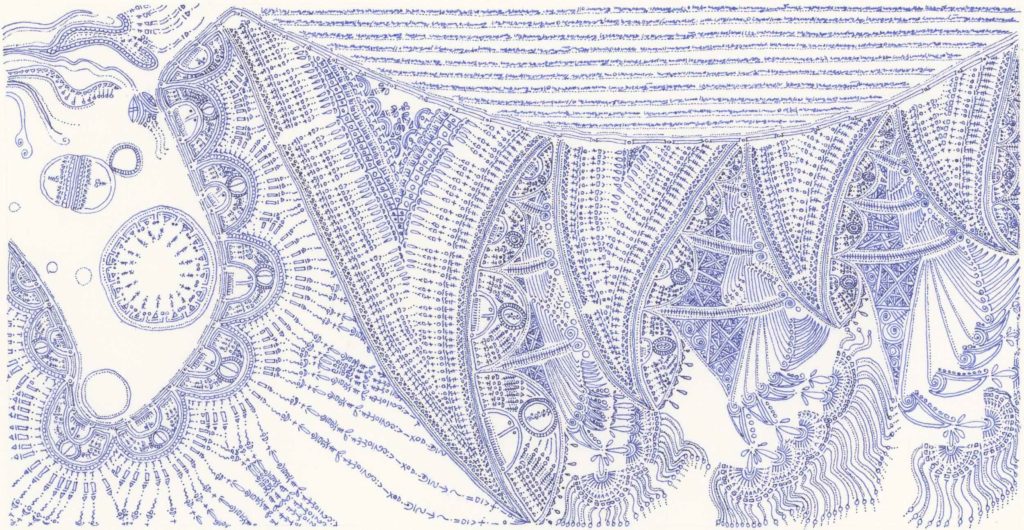
さあ 私のこの大きな翼にお乗り
共に行こう 彼方の地へ》
2012年、紙にインク、10.9×21cm
Born in the Precambrian Period, Draws the Silurian Blue
In her autobiography, Sakagami noted she was “given life at the Precambrian Sea some 590 million years ago.” As the ozone layer was formed during the Silurian period, the vision of blue from the sky and sea was engraved in her mind, inspiring her to reflect this color in works she creates in the present time.
Sakagami’s work became widely known at the exhibition, Parallel Visions (1993), held at Tokyo’s Setagaya Art Museum in 1993. The exhibition, organized as a large-scale art show exploring the relationship between the works of outsider art, or “art brut” artists, and modern and contemporary art pieces, helped Sakagami win recognition as an art brut artist for a long time. Despite this, her works are not by any means the kind that can be easily labeled and classified. Yet one thing that is certain, however, is her creations are free from any academic dogma, such as modern art history and painting theories, and its appeal is accessible to all people.
Rendered on paper using colored pencils, watercolor, or pigments, many of Sakagami’s works are composed of fine lines, drawn primarily in blue, that interlace in numerous ways to form organic shapes. They may even remind you of an aggregate of bacteria or microorganisms. These shapes, when layered, generate a myriad of patterns, including repeated enigmatic curves or ancient Cuneiform, all of which are pieced together to present a universe on paper.
Since the mid-1990s, many of Sakagami’s works have been centered around allover paintings, drawn using media like watercolors, mineral pigments, and colored pencils. Even with works in which the edges appear to have been painted all over, stippling has been used to make a colored block, as small dots can be seen if closely observed. Further, Sakagami’s works were becoming more complex in composition, with ground crystal and other minerals often applied to the surface. These works have such intensity, giving infinite depth to the presentations and captivating the hearts of those who viewed them.
By 2010, Sakagami had begun a series of monochrome drawings on Arches paper using only blue ink. Around this period, she presented two pieces, one after another. The first was NATURALIS HISTORIA, the 2011 piece she created after being inspired by “Voynich Manuscript”, the curiosa discovered in Italy. The second was Scriptures from the Birds, modeled on the “Book of Kells” and presented in 2012. The former is a collection of semi-abstract descriptions of birds, insects, mythical beasts, and divine creatures, accompanied by annotations in a fictional language. The latter spells out various myths and anecdotes featuring birds.
A later collection, Positive Transference Part 1: Chinoiserie (2016) was painted in watercolor on Japanese traditional gampi paper and is linked to a short novel written by Sakagami. It is a series of stories that revolve around a eunuch who works in Changan, the ancient capital of China.
Many of Sakagami’s works are owned by museums including: the National Museum of Art, Osaka; the National Museum of Modern Art, Tokyo; the Hyogo Prefectural Museum of Art; Setagaya Art Museum; the Museum of Modern Art, Wakayama and the Collection de l’Art Brut (Lausanne).
(K.I.)
